|
The
National Women's Conference in Houston, 1977 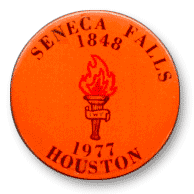
Browse photos of the Houston Conference.
View buttons from 1977 state and
national women's conferences. Read about
the NY State Women's Meeting. Read another account
of the Houston Conference.
 From
November 18 to 21, 1977, over 20,000 people gathered in Houston, Texas
to celebrate International Women's Year and identify goals for women for
the next decade. This was the first and only national women's conference
to be sponsored by the federal government. From
November 18 to 21, 1977, over 20,000 people gathered in Houston, Texas
to celebrate International Women's Year and identify goals for women for
the next decade. This was the first and only national women's conference
to be sponsored by the federal government.
 The
impetus came from the United Nations, which proclaimed 1975 to be International
Women's Year -- later extended to a decade. On January 9, 1974, President
Ford issued Executive Order 11832 creating a National Commission on the
Observance of International Women's Year "to promote equality between
men and women." Numerous events were held over the next two years.
In 1977 President Jimmy Carter chose a new Commission and appointed Bella
Abzug to head it. The
impetus came from the United Nations, which proclaimed 1975 to be International
Women's Year -- later extended to a decade. On January 9, 1974, President
Ford issued Executive Order 11832 creating a National Commission on the
Observance of International Women's Year "to promote equality between
men and women." Numerous events were held over the next two years.
In 1977 President Jimmy Carter chose a new Commission and appointed Bella
Abzug to head it.
 Early in 1975 Rep. Bella Abzug (D. NY) introduced a bill to hold a national
women's conference as part of the Bicentennial celebration. On December
24, 1975, P.L. 94-167 was signed into law by President Ford. Congress
appropriated five million dollars to finance state meetings as well as
the national conference. All but three of the 56 meetings were held in
June and July of 1977. Open to all, about 150,000 people came to elect
2,005 delegates to the national conference and debate 16 resolutions suggested
by the National Commission, based on the research and hearings in its
1976 report "To Form a More Perfect Union."
Early in 1975 Rep. Bella Abzug (D. NY) introduced a bill to hold a national
women's conference as part of the Bicentennial celebration. On December
24, 1975, P.L. 94-167 was signed into law by President Ford. Congress
appropriated five million dollars to finance state meetings as well as
the national conference. All but three of the 56 meetings were held in
June and July of 1977. Open to all, about 150,000 people came to elect
2,005 delegates to the national conference and debate 16 resolutions suggested
by the National Commission, based on the research and hearings in its
1976 report "To Form a More Perfect Union."
 The primary job of the national conference was to formulate and pass a
National Plan of Action, based on recommendations from the state meetings.
The final Plan had 26 planks, ranging from better enforcement of existing
laws to broad demands for a national health security system, full employment,
peace and disarmament.
The primary job of the national conference was to formulate and pass a
National Plan of Action, based on recommendations from the state meetings.
The final Plan had 26 planks, ranging from better enforcement of existing
laws to broad demands for a national health security system, full employment,
peace and disarmament.
 Most of the elected delegates were feminists, but about 20 percent were
opponents of most of the ideas feminists stood for. These delegates were
elected largely from the 15 states which had not ratified the Equal Rights
Amendment. While every plank was vigorously debated, the votes highlighted
a distinctive minority view. Only one of the 26 planks -- on equal credit
-- was approved unanimously, but another 17 were adopted by very large
majorities. On some, such as the ERA, abortion and sexual preference,
the debate was acrimonious.
Most of the elected delegates were feminists, but about 20 percent were
opponents of most of the ideas feminists stood for. These delegates were
elected largely from the 15 states which had not ratified the Equal Rights
Amendment. While every plank was vigorously debated, the votes highlighted
a distinctive minority view. Only one of the 26 planks -- on equal credit
-- was approved unanimously, but another 17 were adopted by very large
majorities. On some, such as the ERA, abortion and sexual preference,
the debate was acrimonious.
 A good deal of ceremony and symbolism accompanied the conference. On September
29 a torch was lighted at Seneca Falls, New York, site of the first women's
rights convention held on July 19, 1848. It was carried by a relay of
runners the 2,600 miles to Houston, arriving the day before the conference
began. Poet Maya Angelou wrote a new Declaration of Sentiments to parallel
the one passed by the 1848 convention. The Declaration accompanied the
torch on its journey where it was signed by thousands.
A good deal of ceremony and symbolism accompanied the conference. On September
29 a torch was lighted at Seneca Falls, New York, site of the first women's
rights convention held on July 19, 1848. It was carried by a relay of
runners the 2,600 miles to Houston, arriving the day before the conference
began. Poet Maya Angelou wrote a new Declaration of Sentiments to parallel
the one passed by the 1848 convention. The Declaration accompanied the
torch on its journey where it was signed by thousands.
 The next day the torch was presented to three First Ladies at the official
opening of the conference, each of whom spoke about herself as a woman,
not just a political wife. They signed the new Declaration and then circulated
it among the delegates to sign.
The next day the torch was presented to three First Ladies at the official
opening of the conference, each of whom spoke about herself as a woman,
not just a political wife. They signed the new Declaration and then circulated
it among the delegates to sign.
 In addition to the delegates, press, and volunteers, several thousand
people came just to be at this historic meeting. Every morning they were
briefed by women in the government before going to workshops, lectures,
exhibits and entertainments. They came to talk with and find each other.
In addition to the delegates, press, and volunteers, several thousand
people came just to be at this historic meeting. Every morning they were
briefed by women in the government before going to workshops, lectures,
exhibits and entertainments. They came to talk with and find each other.
Other accounts of the Houston
Conference
Photos of the 1977 National Women's
Conference by Jo Freeman
|
Please click on thumbnails to view the complete image
|
| |
|
|
| The torch arrives at the Houston convention
center. IWY Commission Chair Bella Abzug leads the way. In
front of her, hand outstretched, is tennis star Billie Jean
King. |
|
| |
| |
|
|
| |
The
torch is passed. From L to R are Lady Bird Johnson, her daughter
Linda (barely visible), Rosalyn Carter, Betty Ford, Maya Angelou,
Bella Abzug. |
|
|
|
| |
Olympic
gold medal winners Donna deVarona and Suzy Chaffee join Houston
athletes Peggy Kokernot, Michele Cearcy, and Sylvia Ortiz
after presentation of the torch inside the convention center.
|
|
|
| |
|
| A line up of prominent women. From L
to R are: Bella Abzug, First Lady Rosalyn Carter, Betty Ford,
Lady Bird Johnson, Linda Johnson Robb, Maya Angelou, Coretta
Scott King, and Judy Carter. |
|
| |
| |
| Prominent women recite the Pledge of Allegiance.
From L to R are: Bella Abzug, First Lady Rosalyn Carter, Betty
Ford, Lady Bird Johnson, Linda Johnson Robb, Maya Angelou,
and Coretta Scott King. |
|
| |
 |
|
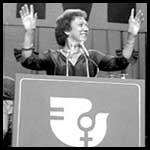 |
|
| |
Poet
Maya Angelou reads the Declaration that she wrote to accompany
the torch. To her left are Bella Abzug, Rosalyn Carter and
Betty Ford. |
|
|
|
| |
Actress Jean Stapleton was one of the IWY Commissioners who
read the Preamble to the National Plan of Action to the delegates.
|
|
|
| |
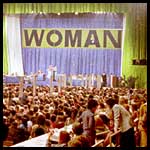 |
|
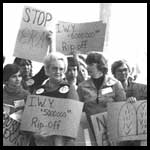 |
|
|
|
|
| |
 |
|
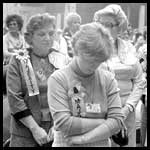 |
| |
Karen Burstein acted as a whip for the New York delegation,
using paper plates on which were written "YES" and
"NO" to tell delegates how the leadership wanted
them to vote. |
|
|
|
| |
Kansas
turns its back on the conference and prays to express its
disapproval. |
|
|
| |

|
|
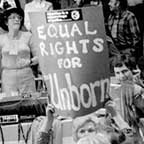 |
| Opinions differed on many
issues, especially abortion. |
|
| |
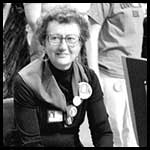 |
|
 |
| Women came from many different
organizations. Dorothy Haener, IWY Commissioner and Representative
of the United Auto Workers (UAW). Betty Hamburger, delegate
from Maryland and Grey Panther activist. |
|
| |
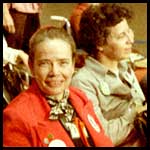 |
|
 |
| Feminist founding mothers:
JoAnn Evansgardner of Pittsburgh and Betty Friedan of New
York |
|
| |
|
|
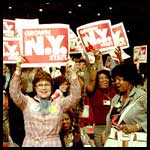 |
|
 |
|
|
|
|
| |
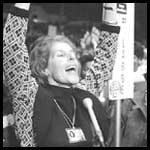 |
|
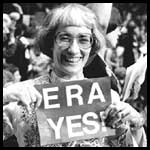 |
| |
Susan
B. Anthony II, grandneice of the Suffrage leader |
|
|
|
| |
Bunny Sandler, delegate from Maryland. |
|
|
| |
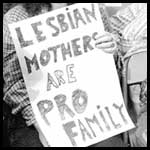 |
|
 |
| While some demonstrated,
others just watched. |
|
| |
| |
| |
|
|